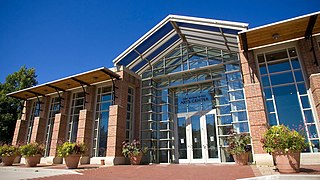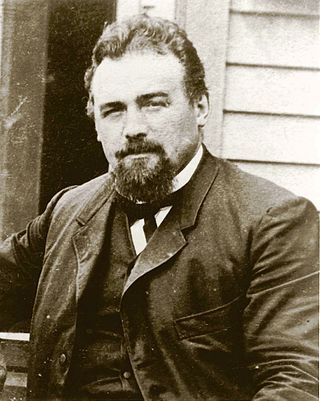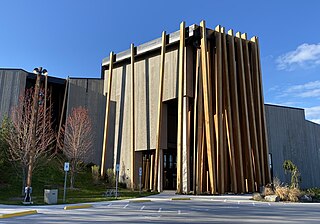Eugene Von Bruenchenhein (1910–1983) was an American self-taught artist from Milwaukee, Wisconsin. Over the course of fifty years, from the 1930s until his death in 1983, Von Bruenchenhein produced an expansive oeuvre of poetry, photography, painting, drawing and sculpture. His body of work includes over one thousand colorful, apocalyptic landscape paintings; hundreds of sculptures made from chicken bones, ceramic and cast cement; pin-up style photos of his wife, Marie; plus dozens of notebooks filled with poetic and scientific musings. Never confined to one particular method or medium, Von Bruenchenhein continually used everyday, discarded objects to visually explore imagined past and future realities.

The Mary Nohl Art Environment is a residence in the Milwaukee suburb of Fox Point, Wisconsin. The property, which is filled with folk art created by artist Mary Nohl (1914–2001), is listed on the National Register of Historic Places.
Scott Reeder is a multi-disciplinary artist in Chicago, IL. He is currently represented by Canada in New York, NY and Kavi Gupta in Chicago, IL.

The John Michael Kohler Arts Center is an independent, not-for-profit contemporary art museum and performing arts complex located in Sheboygan, Wisconsin, United States. The center preserves and exhibits artist-built environments and contemporary art. In 2021, the center opened the Art Preserve, a satellite museum space dedicated to art environments.
Michelle Grabner is an artist, curator, and critic based in Wisconsin. She is the Crown Family Professor of Art at the School of the Art Institute of Chicago where she has taught since 1996. She has curated several important exhibitions, including the 2014 Whitney Biennial at the Whitney Museum of American Art along with Anthony Elms and Stuart Comer, and FRONT International, the 2016 Portland Biennial at the Oregon Contemporary, a triennial exhibition in Cleveland, Ohio in 2018. In 2014, Grabner was named one of the 100 most powerful women in art and in 2019, she was named a 2019 National Academy of Design's Academician, a lifetime honor. In 2021, Grabner was named a Guggenheim Fellow by The John Simon Guggenheim Memorial Foundation.
Raymond "Ray" Kakuo Yoshida was an American artist known for his paintings and collages, and for his contributions as a teacher at the School of the Art Institute of Chicago from 1959 to 2005. He was an important mentor of the Chicago Imagists, a group in the 1960s and 1970s who specialized in distorted, emotional representational art.
Robert Amft was a painter, sculptor, photographer, designer born in Chicago.

John Michael Kohler II was an Austrian American immigrant, industrialist, and politician. He most notably founded and led the Kohler Company and served as the 27th mayor of Sheboygan, Wisconsin. He was the patriarch of the Kohler family of Wisconsin.
Gary Lee Noffke is an American artist and metalsmith. Known for versatility and originality, he is a blacksmith, coppersmith, silversmith, goldsmith, and toolmaker. He has produced gold and silver hollowware, cutlery, jewelry, and forged steelware. Noffke is noted for his technical versatility, his pioneering research into hot forging, the introduction of new alloys, and his ability to both build on and challenge traditional techniques. He has been called the metalsmith's metalsmith, a pacesetter, and a maverick. He is also an educator who has mentored an entire generation of metalsmiths. He has received numerous awards and honors. He has exhibited internationally, and his work is represented in collections around the world.

The Albert Zahn House is located in Baileys Harbor, Wisconsin, United States. It was added to the National Register of Historic Places in 2000.

Rudy Rotter (1913–2001) was an American outsider and self-taught artist residing in Manitowoc, Wisconsin. Raised in Milwaukee, he moved to Manitowoc after the War in the late 1940s to set up a dental practice. After settling in and starting a family, he embarked on a simultaneous career as an artist. In the following decades he produced a prodigious volume of art.
The Kohler Foundation, Inc., is a philanthropic organization that works in the areas of art preservation, grants, scholarships, and performing arts.

John Shimon and Julie Lindemann are American artists who worked together as the collaborative duo J. Shimon & J. Lindemann. Shimon continues to work and teach at Lawrence University. They were born in Manitowoc, Wisconsin, and are best known for their photographs about human existence in the Midwest made using antiquarian photographic processes.
Myra Mimlitsch-Gray is an American metalsmith, artist, critic, and educator living and working in Stone Ridge, New York. Mimlitsch-Gray's work has been shown nationally at such venues as the John Michael Kohler Arts Center, Museum of the City of New York, Metropolitan Museum of Art, Cooper-Hewitt Smithsonian Design Museum, and Museum of Arts and Design. Her work has shown internationally at such venues as the Middlesbrough Institute of Modern Art, Stadtisches Museum Gottingen, and the Victoria and Albert Museum, and is held in public and private collections in the U.S, Europe, and Asia.
Kevin Blythe Sampson is an American artist and retired police officer living in Newark, New Jersey. He makes sculptures from discarded found objects that act as memorials for various people who have died. He has a studio based out of Newark.

Dr. Charles Smith is a visual artist, historian, activist and minister who lives and works in Hammond, Louisiana. His sculptural work focuses on African and African American history.
John David Brcin was an American sculptor and artist.
Mary Le Ravin was an African American visionary artist and ordained minister. She was a self-taught artist best known for creating sculptures, jewelry, household items and trinkets out of animal bones, natural materials, and other found objects.
Ruth DeYoung Kohler II was a museum director and teacher from Wisconsin who championed under-recognized, self-taught artists and vernacular art. She was the director of the John Michael Kohler Arts Center from 1972–2016. She led the development of the Art Preserve in Sheboygan, Wisconsin, the first museum dedicated to the exhibition and conservation of artist-built environments.

The Art Preserve is an art museum and a satellite campus of the John Michael Kohler Arts Center. The preserve houses a collection of artist-built environments and sculptural works. It is designed by Tres Birds and located in Sheboygan, Wisconsin. Opened in June 2021, the Art Preserve is the first museum dedicated to the exhibition, preservation, and care of artist-built environments. The museum also serves as a research space for the art environment genre.








